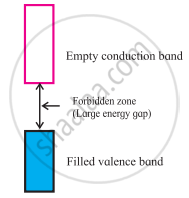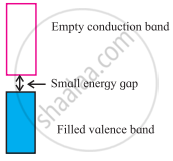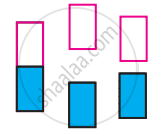Advertisements
Advertisements
Question
Distinguish with the help of diagrams metal conductors, insulators and semiconductors from each other.
Solution
| Metal conductors | Insulators | Semiconductors |
| Metals are good conductors of electricity. | Insulators are nonconductors of electricity. | Semiconductors have conductivity that is intermediate between conductors and insulators. |
| In metal conductors, the conduction band is partially filled and there is no band gap or there is overlapping between the valence band and conduction band. | In insulators, the valence band and conduction band in insulators are separated by a large energy gap called the forbidden zone. | In semiconductors, the valence band is completely filled with electrons, and the conduction band is empty. However, the energy gap between the two bands is smaller than that in an insulator. |
 |
 |
 |
APPEARS IN
RELATED QUESTIONS
Answer the following in one or two sentences.
The following pictures show population of bands for materials having different electrical properties. Classify them as insulator, semiconductor or metal.

Answer the following in one or two sentences.
How does the electrical conductivity of a semiconductor change with temperature? Why?
Answer the following in one or two sentences.
The picture represents bands of MOs for Si. Label valence band, conduction band, and band gap.

Answer the following in brief.
What are valence band and conduction band?
What are n-type semiconductors? Why is the conductivity of doped n-type semiconductor higher than that of pure semiconductor? Explain with diagram.
Explain with diagram, Frenkel defect. What are the conditions for its formation? What is its effect on density and electrical neutrality of the crystal?
Which of the following is a metal?
What is band gap? Arrange band gaps in decreasing order for a semiconductor, metal conductor and insulator.
State the conditions for the formation of Schottky defect. The following picture shows bands for materials having different electrical properties.

Classify them as semiconductors, metals and insulators with reason.
Explain the classification of solids on the basis of electrical conductivity.
